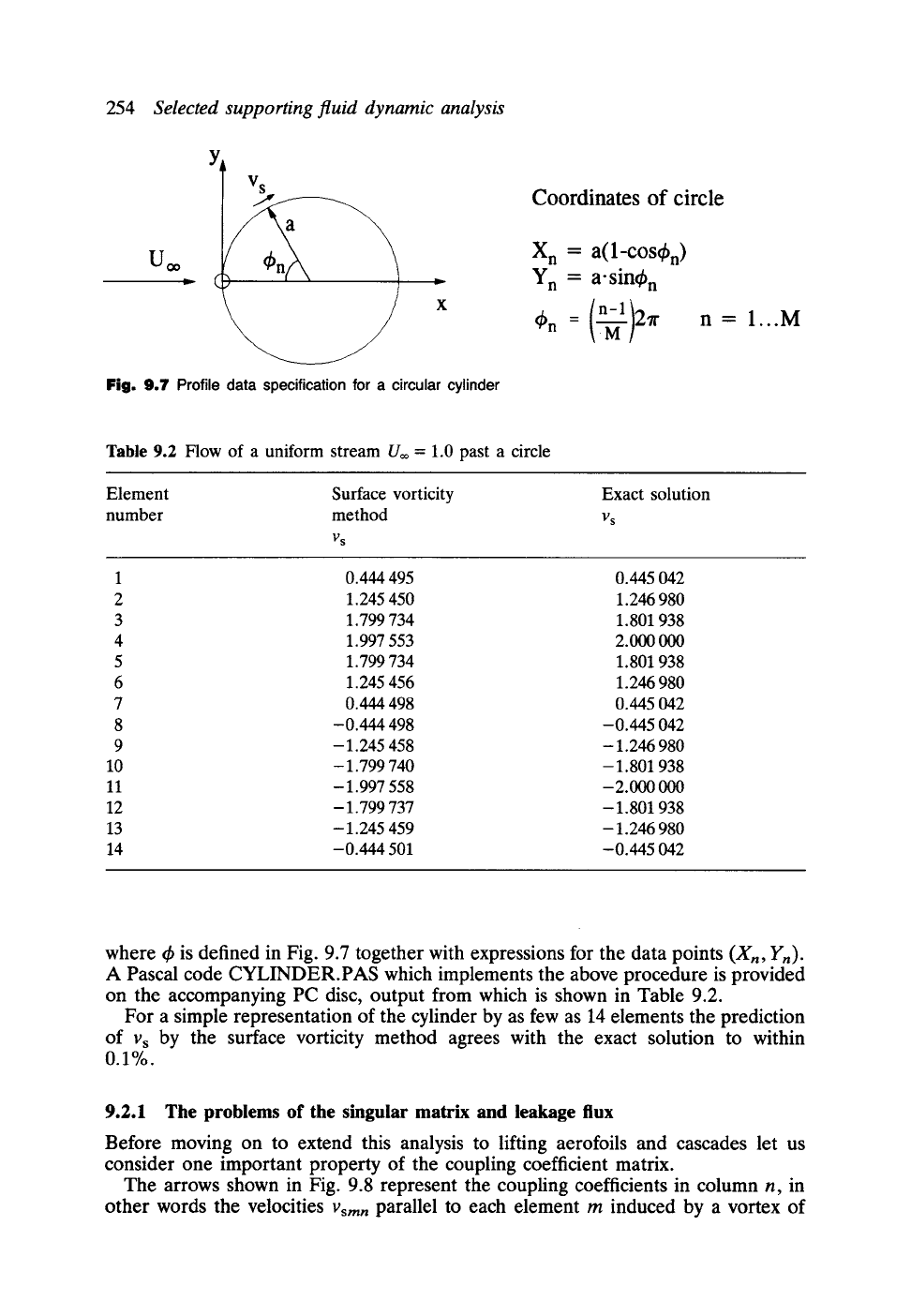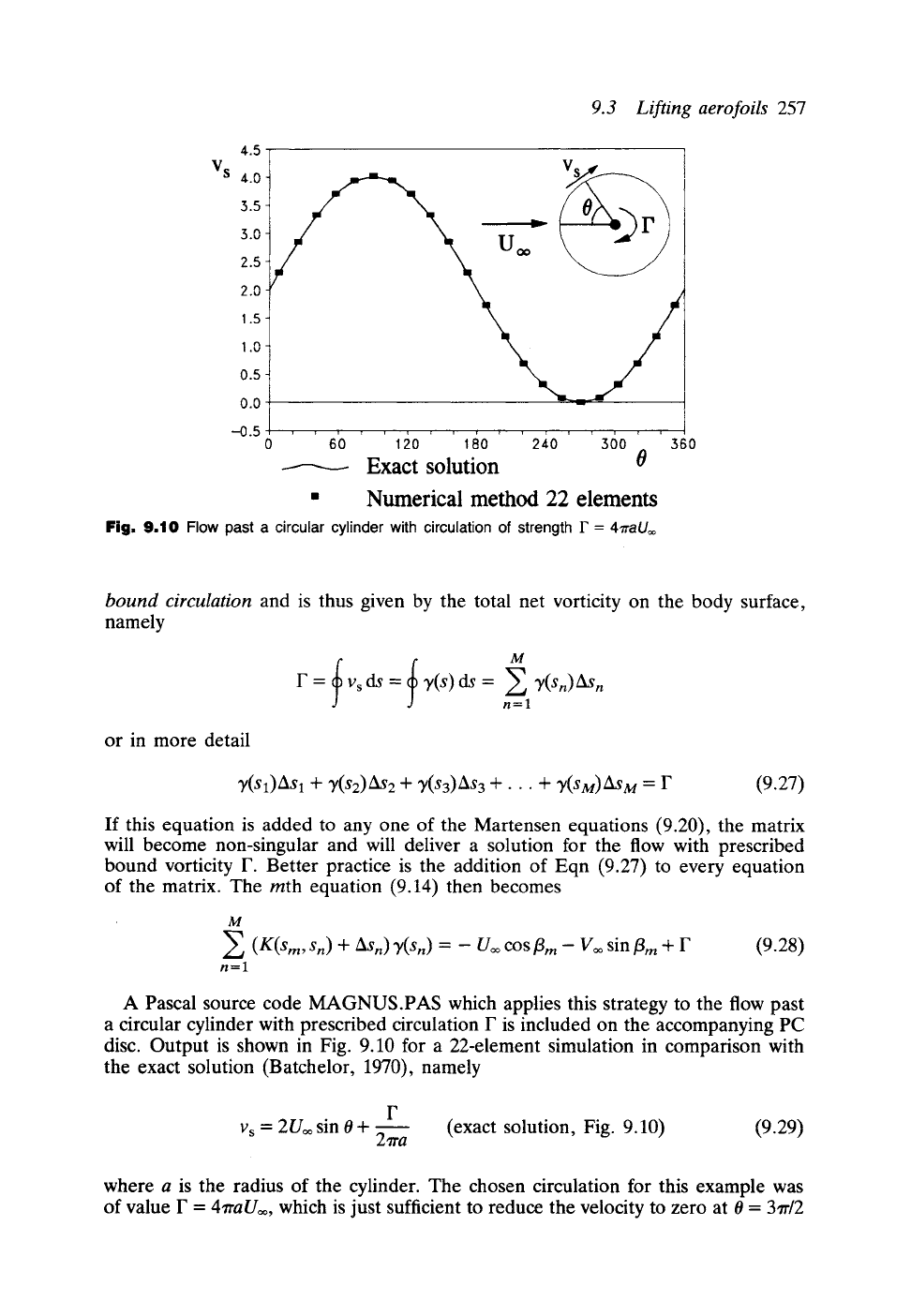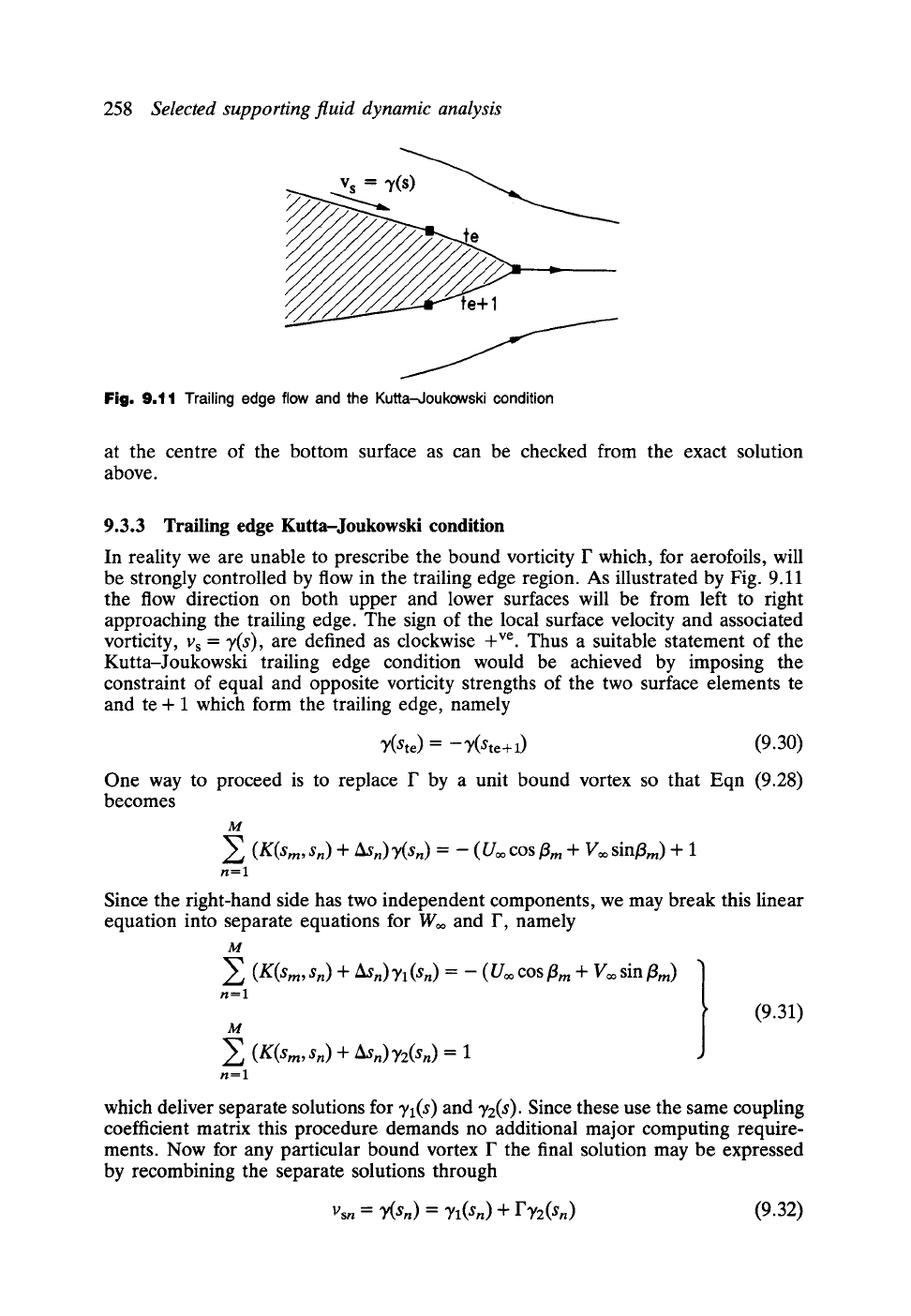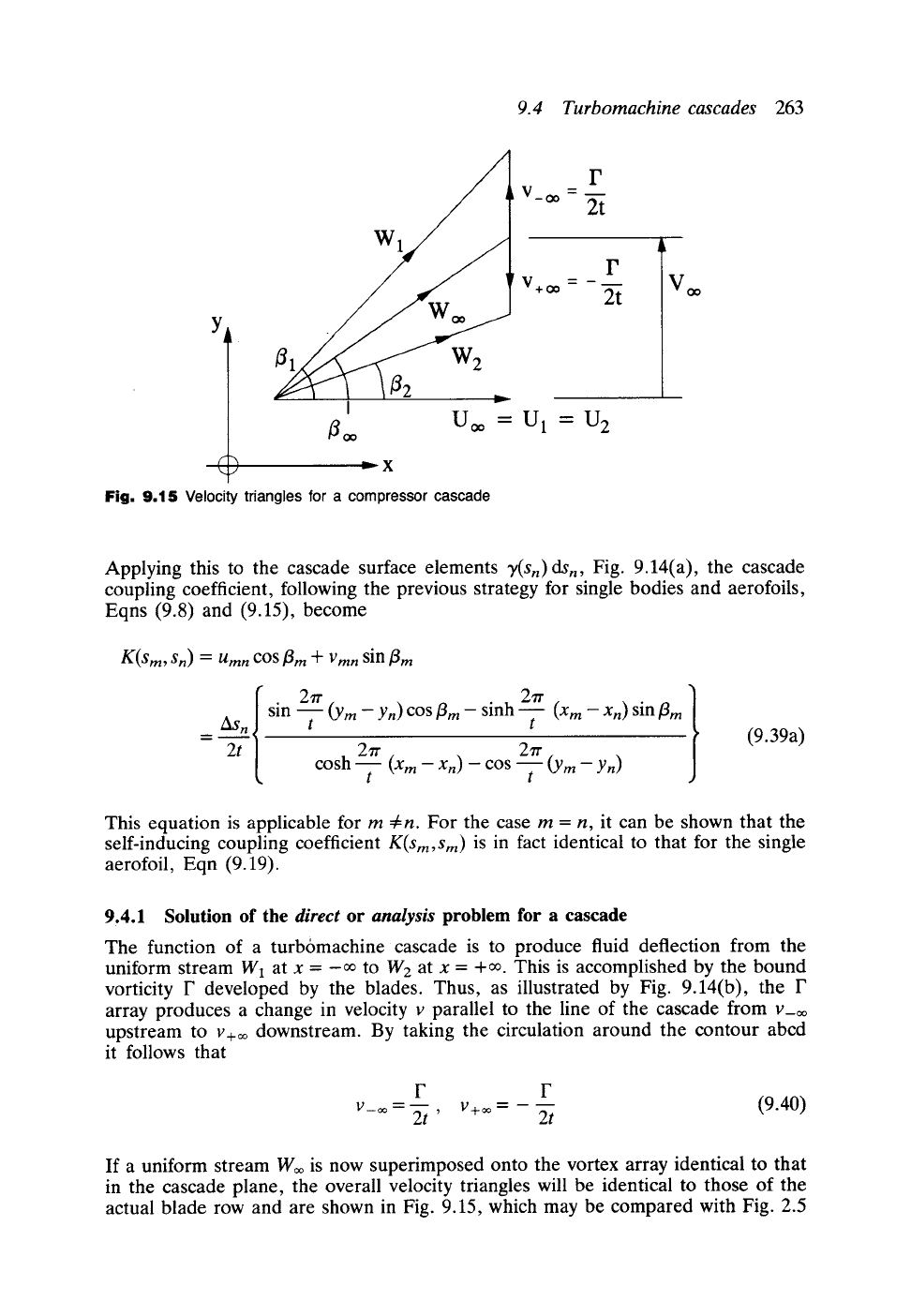Lewis R.I. Turbomachinery Performance Analysis
Подождите немного. Документ загружается.


254
Selected supporting fluid dynamic analysis
= (
V s
Fig. 9.7 Profile data specification for a circular cylinder
Coordinates of circle
X n =
a(1-cos4)n)
Yn = a'sin(hn
U O0
n= 1...M
Table
9.2 Flow of a uniform stream U~ = 1.0 past a circle
Element Surface vorticity Exact solution
number method Vs
k' s
1 0.444 495 0.445 042
2 1.245 450 1.246 980
3 1.799 734 1.801 938
4 1.997 553 2.000 000
5 1.799 734 1.801 938
6 1.245 456 1.246 980
7 0.444 498 0.445 042
8 -0.444 498 -0.445 042
9 - 1.245 458 - 1.246 980
10 - 1.799 740 - 1.801938
11 -1.997 558 -2.000 000
12 - 1.799 737 - 1.801938
13 - 1.245 459 - 1.246 980
14 -0.444 501 -0.445 042
where 4) is defined in Fig. 9.7 together with expressions for the data points (X,,
Yn).
A Pascal code CYLINDER.PAS which implements the above procedure is provided
on the accompanying PC disc, output from which is shown in Table 9.2.
For a simple representation of the cylinder by as few as 14 elements the prediction
of Vs by the surface vorticity method agrees with the exact solution to within
0.1%.
9.2.1 The problems of the singular matrix and leakage flux
Before moving on to extend this analysis to lifting aerofoils and cascades let us
consider one important property of the coupling coefficient matrix.
The arrows shown in Fig. 9.8 represent the coupling coefficients in column n, in
other words the velocities
IPsm n
parallel to each element m induced by a vortex of

9.3 Lifting aerofoils
255
Vortex of unit sheet strength
din = 1.Oxds n
nO -
w
n
m
Note that Vsm n - Kmn
Fig.
9.8 Circulation around profile interior induced by element of unit sheet strength at n
unit sheet strength
dFn =
1.0
x
dsn
located on element n. If we now take the sum
of the products
gmn Z~kS m
for column n, Eqn (9.20), we thus obtain
KlnA~S1 + g2nz~ks2 -]-... + KMnZXSM =
M
E Km,~Sm
m--1
=__ ~ Vsmn dSm
(9.25)
= C, circulation around profile interior
For each column n this represents the circulation around the profile interior due to
the vorticity on element n. Since the vorticity sheet is just outside the body surface,
the circulation C must be zero. Thus this summation for each column should ideally
be zero. In practice due to numerical approximation C will be very small but not
quite zero, implying the presence in the above solution of some leakage flux through
the surface to accommodate the apparent tiny residual internal circulation.
If, on the other hand, the sums of all columns were identically zero, the matrix
would be singular and without the specification of some further constraints no solution
would be forthcoming. The necessity to impose a trailing edge Kutta-Joukowski
condition solves this dilemma for lifting bodies which we will consider next.
9.3 Lifting aerofoils
Simulation of the flow past aerofoils introduces two new problems. Firstly, for thin
body profiles, coupling coefficients on the back-diagonal are inaccurate. Secondly
there is the need to impose the trailing edge Kutta-Joukowski condition related to
the generation of lift. These matters will be dealt with in the next two subsec-
tions.

256
Selected supporting fluid dynamic analysis
Kll K12 K13 K14 /~~ '/
K21 K22 K23 ~//~26
K31 K32 /~/~ K35 K36
K41 /~/~ K44 K45 K46
6
2
4
Fig. 9.9 Back-diagonal coupling coefficients linking opposite body profile points
9.3.1 Back-diagonal correction
To illustrate this problem the full matrix is shown in Fig. 9.9 for a thin profile,
adopting just six elements for simplicity.
Coefficients on the back-diagonal represent the mutual influence of vortex elements
directly opposite one another, namely
g16
and K61, K25 and K52,
K34
and K43. As
shown in detail by the present author (Lewis, 1991), for very thin bodies such as
aerofoils these coupling coefficients become both large and inaccurate, resulting in
considerable residual circulation C, Eqn (9.25). The recommended procedure to
correct for this, first advocated by Jacob and Riegels (1963), is to enforce zero internal
circulation C = 0 for each column. To illustrate this, application of Eqn (9.25) to
column 4 of Fig. 9.9 results in
1
K34 --- - 3 ~ (K14~kSl q" K24~$2 -b g44z~ 4 + g54z~s 5 q- g64z~ks6)
(9.26)
If this estimate for
K34
and all the other back diagonal coefficients is used instead
of the normal value as given by Eqn (9.15), 'numerical leakage flux' is eliminated,
ensuring that the body profile is a true streamline of the flow. However, the matrix
will then be singular and insoluble without further actions such as those to be
considered next.
9.3.2 Introduction of bound circulation
The most obvious way of making the matrix non-singular is to impose also a value
for the circulation F = ~Vs ds around the outside of the body profile. F is called the

9.3 Lifting aerofoils
257
4.5
VS 4.0
3.5
3.0
2.5
2.0
1.5
1.0
0.5
0.0
-0.5
'1~0' '~80' '220' '360' '380
Exact solution O
Numerical method 22 elements
'
'sb
Fig.
9.10 Flow past a circular cylinder with circulation of strength F =
4r
bound circulation
and is thus given by the total net vorticity on the body surface,
namely
;
M
ds -" ~ T( Sn ) Z~kSn
n=l
or in more detail
~/(s1)As 1 -t- ')/(S2)Z~ 2 -t- 'Y(s3)As 3 "4-... -t-
"Y(SM)~tS M = F
(9.27)
If this equation is added to any one of the Martensen equations (9.20), the matrix
will become non-singular and will deliver a solution for the flow with prescribed
bound vorticity F. Better practice is the addition of Eqn (9.27) to every equation
of the matrix. The mth equation (9.14) then becomes
M
(g(s m, Sn) q- i~iSn) T(Sn) "~ - Uoo
cos tim -- Voo
sin
tim d- F
n=l
(9.28)
A Pascal source code MAGNUS.PAS which applies this strategy to the flow past
a circular cylinder with prescribed circulation F is included on the accompanying PC
disc. Output is shown in Fig. 9.10 for a 22-element simulation in comparison with
the exact solution (Batchelor, 1970), namely
F
Vs = 2/./= sin 0-~ 27ra (exact solution Fig. 9 10) (9.29)
where a is the radius of the cylinder. The chosen circulation for this example was
of value F =
4~raU=,
which is just sufficient to reduce the velocity to zero at 0 = 37r/2

258
Selected supporting fluid dynamic analysis
, Vs = 7(~
Fig. 9.11
Trailing edge flow and the Kutta-Joukowski condition
at the centre of the bottom surface as can be checked from the exact solution
above.
9.3.3 Trailing edge
Kutta-Joukowski condition
In reality we are unable to prescribe the bound vorticity F which, for aerofoils, will
be strongly controlled by flow in the trailing edge region. As illustrated by Fig. 9.11
the flow direction on both upper and lower surfaces will be from left to right
approaching the trailing edge. The sign of the local surface velocity and associated
vorticity, Vs = y(s), are defined as clockwise +ve. Thus a suitable statement of the
Kutta-Joukowski trailing edge condition would be achieved by imposing the
constraint of equal and opposite vorticity strengths of the two surface elements te
and te + 1 which form the trailing edge, namely
~(Ste) -- --'Y(Ste+l) (9.30)
One way to proceed is to replace F by a unit bound vortex so that Eqn (9.28)
becomes
M
Z (g(sm' Sn) + z2~Sn) "}t(Sn) = - (U~176
cos tim + Voo sin/3m) +
1
n=l
Since the right-hand side has two independent components, we may break this linear
equation into separate equations for Woo and F, namely
M
Z (K(sm, Sn) + ASh)
7a (S~) = -- (Uoo cos/3m + Voo sin/3m)
n=l
M
Z (K(sm' Sn) +ASn)
T2(Sn)
n=l
=1
(9.31)
Vs, = y(s,,)= 71(s,,)+ FTz(s,) (9.32)
which deliver separate solutions for
~1(S)
and 72(s). Since these use the same coupling
coefficient matrix this procedure demands no additional major computing require-
ments. Now for any particular bound vortex F the final solution may be expressed
by recombining the separate solutions through

9.3 Lifting aerofoils
259
Introducing this expression into the trailing edge equation (9.30) we may then obtain
the following solution for the aerofoil bound vorticity:
F = - ')tl(Ste) + ')tl(Ste+l)
~2(Ste) + ')t2(Ste+ 1) (9.33)
As it stands the solution of Eqn (9.31) is required for each mainstream velocity
specification (Woo, aoo). A further simplification is obtained if Eqn (9.31a) is broken
down yet again into two separate equations for unit uniform streams Uoo = 1 and
Vo~ = 1 in the x and y directions, resulting in the following three independent
unit
equations:
M
E
(K(sm'
Sn) + z~Sn)'Yu(sn)
= -- COS
tim
for U= = 1, V= = 0
n=l
M
2 (g(Sm' Sn) + z~ISn)
]tv(Sn)
= --
sin/3m for Uo~ = 0, V= = 1 (9.34)
n=l
M
E (g(Sm
n=l
, Sn) + ~kSn)'YF(Sn)
=
1
for F=I
These may be solved once and for all and the results recombined for any desired
values of Uoo, Voo in the following manner. First apply the Kutta condition, Eqn (9.33),
to the two unit uniform stream solutions to give the unit bound vortex strengths Fu
and Fv, namely
Fu = _ 'yu(Ste) + ~u(Ste+ 1)
'YF(Ste) + )tF(Ste+ 1)
Fv = - Yv(Ste) + yv(Ste+i)
Yr(Ste) + Yr(Ste+ 1)
(9.35)
The solution for any specified values of U~ and V~ then becomes
v~. = U~[Yu(Sn) + ru yr(s.)]
+
Voo[~v(Sn) + Fv
yr(sn)l
and the total bound vorticity is given by
(9.36)
F = U~ F~ + V~ Fv (9.37)
Example 9.2 Flow past an aerofoil
The program AEROFOIL.PAS (source code given on accompanying PC disc)
completes this computation, an example of which is shown in Fig. 9.12 for profile
NACA0012 with a circular arc camber line and angle 0 = 30 ~ Either of the programs
CASCADE or STACK may be used to generate the profile coordinates following
the standard geometrical specification explained in Section 2.3, the data being

260
Selected supporting fluid dynamic analysis
'.~ I
Cp
o.5. i
n
~oorom CASCADE
Progrom AEROFOIL
0.0
-0.5
-1.0
-1.5+-
0.00
0.25 0.50 X~ 0.75 1.00
Profile
-
NACA0012 Circular arc camber 0= 30 ~
W**= 1.0, a** = 2 ~ (t/l = 100 for CASCADE
calculation)
Fig. 9.12 Comparison of surface pressure distribution predicted by programs CASCADE and
AEROFOIL
recorded in the file RAWDATA. The predicted distribution of surface pressure
coefficient Cp, as defined by Eqn (2.14), is compared here with that predicted by
the program CASCADE, for which an extremely wide blade pitch
t/l
= 100 was
introduced to simulate the isolated profile. The two programs are in close
agreement.
9.3.4 Computational flow sequence for programs AEROFOIL.PAS and
BLADEROW.PAS
To conclude this section the overall computational flow sequence for prediction of
the flow past an aerofoil is illustrated in Fig. 9.13. All the procedures up to and
including calculation of the unit solutions are totally independent of the mainstream
velocity W~ and are calculated once and for all for the given aerofoil profile. The
program then permits the selection of successive values of Woo and aoo as required.
The reader is referred to the source code AEROFOIL.PAS for further details.
This same computational sequence is appropriate for surface vorticity analysis of
turbomachine cascade flows which will be considered in the next section.
9.4 Turbomachine cascades
The previous analysis may be extended quite easily to deal with turbomachine aerofoil
or blade cascades by introduction of an alternative coupling coefficient
K(sm,Sn)
which automatically accounts for the complete array of blades located between
y = +oo, Fig. 9.14(a). To derive an expression for
K(sm,S,)
consider first the infinite
array of point vortices of strength F, Fig. 9.14(b). As shown by Traupel (1945) and

Read Xn,Y n profile
coordinates
from file
Data preparation.
Pivotal points and tim values
Calculation of
coupling coefficients
and right-hand sides
Back-diagonal
correction
t
Add on unit vortex
(Eqn (9.27) with F = 1)
Invert matrix and
calculate unit solutions
t ,
Input uniform stream data
W= and c~o,
Solution for 7(s)= v s and
hence CR distribution and CL
yes
no
Fig. 9.13 Computational sequence for programs AEROFOIL and BLADEROW

262
Selected supporting fluid dynamic analysis
~'(s)ds
V
u
--
X
v
(a) (b)
(
Q
F
d
Y~
F
F
E~
~F
b
V
c
+00
Fig. 9,14 (a) Turbomachine cascade and (b) equivalent infinite array of point vortices
I'
2t
--- X
v
developed in detail by Lewis (1991), the complex conjugate velocity induced by the
infinite vortex array may be expressed as
iF (2) iF(eZ+l) (9.38a)
u-iv=-~cosh =-~ e ~-1
_iF(sinhx-isiny)___ (9.38b)
2t cosh x - cosy
Most cascade treatments transform this to normalised coordinates of the following
iF
u - iv -- --~-
form"
sinh 27rx i sin 2-try
t t
cosh 27rx 2"try
-- COS
t t
Separating the real and imaginary parts, the (u, v) velocity components are thus
U =
V =
sin
F t
2~ry
2t
cosh ~ -
2,rx 270,
COS
t t
2~x
sinh
t
2t
cosh ~ -
2,rx
COS
2try
(9.39)
t t

9.4 Turbomachine cascades
263
F
L V_oo = -~
W 1
F
r V+c~
-.~
,,....-
~oo U~176
= U1 = U2
~X
Fig. 9.15 Velocity triangles for
a compressor
cascade
V
OO
Applying this to the cascade surface elements
"}/(Sn) dSn,
Fig. 9.14(a), the cascade
coupling coefficient, following the previous strategy for single bodies and aerofoils,
Eqns (9.8) and (9.15), become
K(sm, Sn) -- Umn
COS
[~m + l"mn
sin
~m
271"
As__.___~n sin
~
(Ym --
Yn)
COS
tim --
sinh 2zr
t (Xm - xn)
sin
tim
2t cosh 27r 2zr
t (Xm - Xn) -
cos
t (Ym
- Y n)
(9.39a)
This equation is applicable for m :r For the case m = n, it can be shown that the
self-inducing coupling coefficient
g(sm,Sm)
is in fact identical to that for the single
aerofoil, Eqn (9.19).
9.4.1 Solution of the
direct
or
analysis
problem for a cascade
The function of a turbomachine ' cascade is to produce fluid deflection from the
uniform stream W1 at x = -oo to W2 at x = +oo. This is accomplished by the bound
vorticity F developed by the blades. Thus, as illustrated by Fig. 9.14(b), the F
array produces a change in velocity v parallel to the line of the cascade from v_o~
upstream to v+o~ downstream. By taking the circulation around the contour abcd
it follows that
F F
v_o~- 2t ' v+o~- 2t (9.40)
If a uniform stream Wo~ is now superimposed onto the vortex array identical to that
in the cascade plane, the overall velocity triangles will be identical to those of the
actual blade row and are shown in Fig. 9.15, which may be compared with Fig. 2.5
